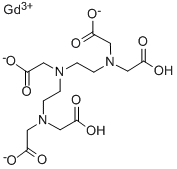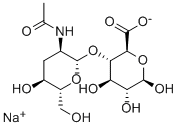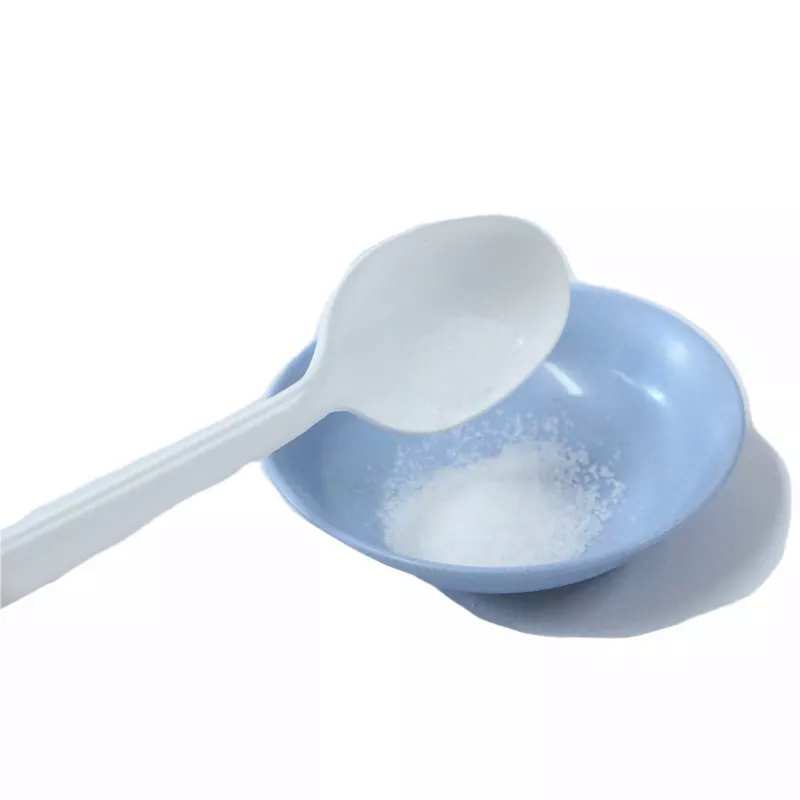Diethylenetriaminepentaacetic acid
Synonym(s):DTPA;Diethylenetriaminepentaacetic acid;Pentetic acid;Titriplex V;DETAPAC
- CAS NO.:67-43-6
- Empirical Formula: C14H23N3O10
- Molecular Weight: 393.35
- MDL number: MFCD00004289
- EINECS: 200-652-8
- SAFETY DATA SHEET (SDS)
- Update Date: 2025-12-29 14:06:09

What is Diethylenetriaminepentaacetic acid?
Absorption
DTPA and its trisodium salts present a very poor bioavailability after oral administration. Therefore, the normal administration of DTPA is done by slow intravenous infusion or inhalation with a nebulizer. When inhaled, the absorption is of about 20% of the administered dose.
Toxicity
Some toxicity has been reported related to administration of pentetic acid including depletion of trace metals, kidney and liver vacuolization and small bowel hemorrhage lesions.
Chemical properties
Pentetic acid occurs as a white crystalline solid and is almost odorless.
Chemical properties
Diethylenetriaminepentaacetic acid is a solid.
The Uses of Diethylenetriaminepentaacetic acid
Diethylenetriaminepentaacetic Acid is a component of manganese and zinc fertilizers.
The Uses of Diethylenetriaminepentaacetic acid
chelating agent, diagnostic aid
The Uses of Diethylenetriaminepentaacetic acid
Diethylenetriaminepentaacetic acid is used as chelating agent and forms complexes with metal ions. It finds application as a magnetic resonance imaging (MRI) contrasting agent, since it improves the image by forming a complex with a gadolinium ion. It can also be used for treatment of radioactive materials such as plutonium, americium and other actinides. It is an active component of manganese and zinc fertilizers used in agrochemical industry. It acts as a color inhibitor and is used in the production of acrylon. It is also used in soaps as a water softener.
Indications
DTPA is widely used in industry and medicine. As a medical agent, it is approved for its use in medical imaging and for the decorporation of internally deposited radionuclides. It is FDA approved for the treatment of individuals with known or suspected internal contamination with plutonium, americium or curium to increase the rates of elimination.
Due to the pharmacokinetic elimination by the kidneys, pentetic acid conjugated with technetium Tc-99m is being used clinically to estimate physiological parameters such as glomerular filtration rat and effective renal plasma flow.
Background
Pentetic acid, also known as diethylenetriaminepentaacetic acid (DTPA), is a synthetic polyamino carboxylic acid with eight coordinate bond forming sites that can sequester metal ions and form highly stable DTPA-metal ion complexes. DTPA, along with its calcium and zinc trisodium salts, are the only FDA approved agents for the treatment of internal contamination by transuranics. It is currently considered, in all the dosage forms, as a member of the list of approved inactive ingredients for drug products by the FDA. DPTA was developed by the pharmaceutical company CIS US and FDA approved on April 14, 2004.
What are the applications of Application
Diethylenetriaminepentaacetic acid is an aminopolycarboxylic acid
Production Methods
Pentetic acid is a pentaacetic acid triamine formed during the preparation of the amino carboxylic acid and its salt.
Definition
ChEBI: Pentetic acid is a pentacarboxylic acid. It has a role as a copper chelator. It is a conjugate acid of a pentetate(1-).
General Description
Visit our Titration Center to learn more.
Pharmaceutical Applications
Pentetic acid is mainly used as a chelating agent in the preparation of imaging and contrast agents for radionuclide and magnetic resonance imaging.It is also used as a carrier excipient for neutron-capture isotopes in, for example, radiotherapy.Pentetic acid–isotope complexes have also been considered as model active substances in scintigraphic imaging studies.Pentetic acid has been used to chelate metal ions to reduce formation of reactive oxygen species during lyophilization.
Pharmacokinetics
There are reports in vivo of low stability of complexes of DPTA with uranium and neptunium which is being reported to cause deposition of the radionuclides into the tissues. In the case of plutonium, some preclinical studies have shown a very high urine elimination efficacy 1 hour after initial contamination. This efficacy is conserved for approximately 24 hours while the radiocontaminant is circulating. When the radionuclide is inhaled, it has been reported a DPTA-induced reduction of even 98% of the lung deposits. It is important to consider that pentetic acid can bind directly to other trace metals in the body which can cause deficiencies.
Safety Profile
Moderately toxic by intraperitoneal route. When heated to decomposition it emits toxic fumes of NOx.
Safety
Pentetic acid is used in intrathecal and intravenous injection
preparations. The pure form of pentetic acid is moderately toxic
by the intraperitoneal route.
LD50 (mouse, IP): 0.54 g/kg
LD50 (mouse, oral): 4.84 g/kg
Metabolism
Pentetic acid and its derivatives present a very minimal metabolism in the body.
Storage
The activity of pentetic acid as a chelating agent may cause unwanted effects in formulations containing metal ions. The desired chelate may be displaced by other ions from the formulation.
Purification Methods
Crystallise DTPA from water. Dry under vacuum or at 110o. [Bielski & Thomas J Am Chem Soc 109 7761 1987, NMR: Wenzel et al. Anal Chem 54 615 1982, Beilstein 4 IV 2454.]
Incompatibilities
The activity of pentetic acid as a chelating agent may cause unwanted effects in formulations containing metal ions. The desired chelate may be displaced by other ions from the formulation.
Regulatory Status
Included in the FDA Inactive Ingredients Database (intrathecal and intravenous injections). Included in intravenous and intra-articular injections licensed in the UK.
Properties of Diethylenetriaminepentaacetic acid
| Melting point: | 219-220 °C (lit.) |
| Boiling point: | 517.84°C (rough estimate) |
| Density | 1.56 |
| refractive index | 1.5700 (estimate) |
| Flash point: | 200 °C |
| storage temp. | room temp |
| solubility | 0.1 M NaOH: 0.1 M at 20 °C, clear, colorless |
| form | Crystalline Powder |
| pka | pK1:;pK2:2.55(+1);pK3:4.33(+2);pK4:8.60(-3);pK5,10.58 (25°C) |
| color | White to almost white |
| PH | 2-3 (H2O, 20℃)(saturated solution) |
| Water Solubility | 5 g/L (20 ºC) |
| Merck | 14,7125 |
| BRN | 1810219 |
| Stability: | Stable. Incompatible with strong oxidizing agents. |
| CAS DataBase Reference | 67-43-6(CAS DataBase Reference) |
| NIST Chemistry Reference | N,N-Bis(2-(bis-(carboxymethyl)amino)ethyl)-glycine(67-43-6) |
| EPA Substance Registry System | Pentetic acid (67-43-6) |
Safety information for Diethylenetriaminepentaacetic acid
| Signal word | Warning |
| Pictogram(s) |
 Exclamation Mark Irritant GHS07  Health Hazard GHS08 |
| GHS Hazard Statements |
H319:Serious eye damage/eye irritation H332:Acute toxicity,inhalation H373:Specific target organ toxicity, repeated exposure |
| Precautionary Statement Codes |
P201:Obtain special instructions before use. P202:Do not handle until all safety precautions have been read and understood. P260:Do not breathe dust/fume/gas/mist/vapours/spray. P305+P351+P338:IF IN EYES: Rinse cautiously with water for several minutes. Remove contact lenses, if present and easy to do. Continuerinsing. P308+P313:IF exposed or concerned: Get medical advice/attention. |
Computed Descriptors for Diethylenetriaminepentaacetic acid
| InChIKey | QPCDCPDFJACHGM-UHFFFAOYSA-N |
Diethylenetriaminepentaacetic acid manufacturer
JSK Chemicals
Ozone Enterprise
Cynor Laboratories
New Products
4,4-Difluoropiperidine hydrochloride tert-butyl 9-methoxy-3-azaspiro[5.5]undecane-3-carboxylate Indole Methyl Resin N-Isopropylurea N,N-Dicyclohexylcarbodiimide(DCC) MELDRUMS ACID 5-METHYLISOXAZOLE-4-CARBOXYLIC ACID Magnessium Bis glycinate Zinc ascorbate 1-bromo-2-butyne 2-acetamidophenol 9(10H)-anthracenone Erythrosin B, 4-Piperidinopiperidine 2-((4-morpholinophenylamino) (methylthio) methylene) malononitrile 2,4-dihydroxybenzaldehyde 3-(4-morpholinophenylamino)-5-amino-1H-pyrazole-4-carbonitrile Methyl 2-methylquinoline-6-carboxylate 2,6-dichloro-4-nitropyridine 4-Bromo-2-chlorobenzonitrile 2-(benzylamino)acetic acid hydrochloride 4-(tert-Butoxycarbonylamino)but- 2-ynoic acid 3,4-dihydro-2H-benzo[b][1,4]dioxepine 1-Phenyl-1-cycloprppanecarboxylicacidRelated products of tetrahydrofuran








You may like
-
 67-43-6 Diethylentriaminepentaacetic acid, 98% 98%View Details
67-43-6 Diethylentriaminepentaacetic acid, 98% 98%View Details
67-43-6 -
 Diethylenetriaminepentaacetic Acid (DTPA) extrapure AR CAS 67-43-6View Details
Diethylenetriaminepentaacetic Acid (DTPA) extrapure AR CAS 67-43-6View Details
67-43-6 -
 Diethylenetriaminepentaacetic acid 95% CAS 67-43-6View Details
Diethylenetriaminepentaacetic acid 95% CAS 67-43-6View Details
67-43-6 -
 Diethylenetriaminepentaacetic acid 98% (HPLC) CAS 67-43-6View Details
Diethylenetriaminepentaacetic acid 98% (HPLC) CAS 67-43-6View Details
67-43-6 -
 Diethylenetriaminepentaacetic acid, ≥99% (titration) CAS 67-43-6View Details
Diethylenetriaminepentaacetic acid, ≥99% (titration) CAS 67-43-6View Details
67-43-6 -
 Diethylenetriaminepentaacetic acid, GR 99%+ CAS 67-43-6View Details
Diethylenetriaminepentaacetic acid, GR 99%+ CAS 67-43-6View Details
67-43-6 -
 Chemical Processing DIETHYLENE TRIAMINE PENTA ACETIC ACID LR 1kgView Details
Chemical Processing DIETHYLENE TRIAMINE PENTA ACETIC ACID LR 1kgView Details
67-43-6 -
 Diethylenetriaminepentaacetic DTPA Acid, For Chelate Agent, Packaging Type: HDPE BagView Details
Diethylenetriaminepentaacetic DTPA Acid, For Chelate Agent, Packaging Type: HDPE BagView Details
67-43-6
